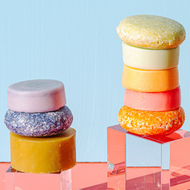How to Remove Labels from Glass Bottles and Jars

Preserving glass bottles and jars can be a rewarding hobby or a sustainable practice, whether you're repurposing them for DIY projects, storage, or decoration. However, removing labels and their sticky residue can be a daunting task. This article will guide you through simple, effective methods to reclaim your glass items.
How to Remove Labels from Glass
Materials Needed
- Warm water
- Dish soap
- Baking soda
- Any cooking oil
- Scrubbing natural loofah, dish scrubber or reusable dishcloth
- Razor blade or scraper tool (optional)
Method 1: Soaking
This is the most common and easiest way to remove labels.
-
Fill a Sink or Tub: Fill your sink or a tub with warm water and a few squirts of dish soap.
-
Soak the Bottles: Submerge your glass bottles or jars fully in the water. Let them soak for at least an hour, or until the labels start to loosen.
-
Peel Off the Labels: After soaking, labels should be easy to peel off. If they resist, use a scraper tool or a razor blade to gently lift the edges.
-
Wash and Dry: Once the labels are off, wash the bottles or jars with soap and water, then dry.
Method 2: Baking Soda and Oil
For tougher labels or more adhesive residue, a baking soda and oil paste can work wonders.
-
Mix a Paste: Combine equal parts of baking soda and cooking oil to create a paste.
-
Apply the Paste: Spread this mixture over the label or residue and let it sit for 15 minutes.
-
Scrub Off the Residue: Using a scrubbing sponge or cloth, gently scrub the area where the paste is applied. The residue should start to lift off.
-
Rinse and Dry: Rinse the bottles or jars with warm water, then dry.
Method 3: Using Goo Gone
If the residue still persists, a product like Goo Gone can be the final solution.
-
Apply Goo Gone: Apply a small amount of Goo Gone to the residue, following the product's instructions.
-
Wait and Wipe: Let the Goo Gone sit on the residue for a few minutes, then wipe away with a cloth.
-
Wash and Dry: As with other methods, wash the bottles or jars with soap and water, then dry.
Questions & Answers + Essential Tips for Effortlessly Removing Labels from Jars
Pictured: Clean, empty glass food jars elegantly arranged on a wooden table.
Is the dish soap and baking soda method for removing labels eco-friendly?
Indeed, using dish soap and baking soda is an environmentally-conscious choice for label removal. Ensure you're opting for a gentle dish soap, like our zero-waste dish soap. This method stands as a green and safe alternative to other cleaning solutions like washing soda or rubbing alcohol.
Can I use washing soda to remove labels from jars?
Yes, washing soda can effectively detach stubborn labels from glass jars. In this scenario, simply substitute vinegar and/or baking soda with washing soda. Despite its A rating from the Environmental Work Group for eco-friendly cleaning, remember that washing soda is not consumable and can cause skin burns. Therefore, don protective gloves when using it.
Can I use rubbing alcohol to remove labels from jars?
Rubbing alcohol can indeed be employed for label removal, but it's worth noting that it's not the greenest choice. Although it's a potent disinfectant with various household uses, the Material Safety Data Sheet for isopropyl alcohol advises caution due to potential skin irritation and serious harm if ingested, not to mention its flammability. For label removal, we'd recommend sticking to safer options like eco-friendly dish soap and baking soda.
Can I use a hairdryer to remove labels from jars?
While a hairdryer can be utilized to melt the adhesive by directing hot air onto the label, you'll still need to soak the jar or apply oil to remove the stickiness. To make the process more efficient, we suggest directly soaking the jar in hot water mixed with soap, vinegar, and baking soda, which will facilitate the removal of the adhesive glue.
Does the dish soap and baking soda method damage jars?
No, removing labels using a natural dish soap and baking soda does not harm the jars. Post cleaning, they can be safely repurposed for various household needs or food storage.
Does the dish soap and vinegar method work on all jars and labels?
In general, a combination of dish soap and vinegar should successfully remove all paper labels from beer, wine, champagne, and other types of jars. If any sticky residue persists, an oil and baking soda blend can be used to scrub off the stubborn paper labels.
Screen-printed labels, such as dates or certain beer bottle labels, might require a more vigorous scrub. However, please note that labels etched into the bottle cannot be removed.
Does the dish soap and vinegar method work on metal?
Absolutely! You can eliminate sticky paper labels from metal using a gently dish soap and vinegar, adding a small quantity of baking soda if needed. Simply follow the aforementioned steps for glass jar label removal, and you'll have spotless metal containers ready for reuse.
Tips and Warnings
- Always handle razor blades and scraper tools carefully to avoid injury.
- If you're dealing with a lot of bottles or jars, you might want to work in batches.
- Always test a small area first when using products like Goo Gone to ensure it doesn't damage the glass.
A must have Zero-Waste Essentials you might need during this task:
Reusable dishcloths, Natural loofah sponge, A biodegradable dish scrubber.
With these simple steps, you can efficiently remove labels from glass bottles and jars, turning them into versatile items for your home, office, or next DIY project. Happy recycling and repurposing!









Leave a comment